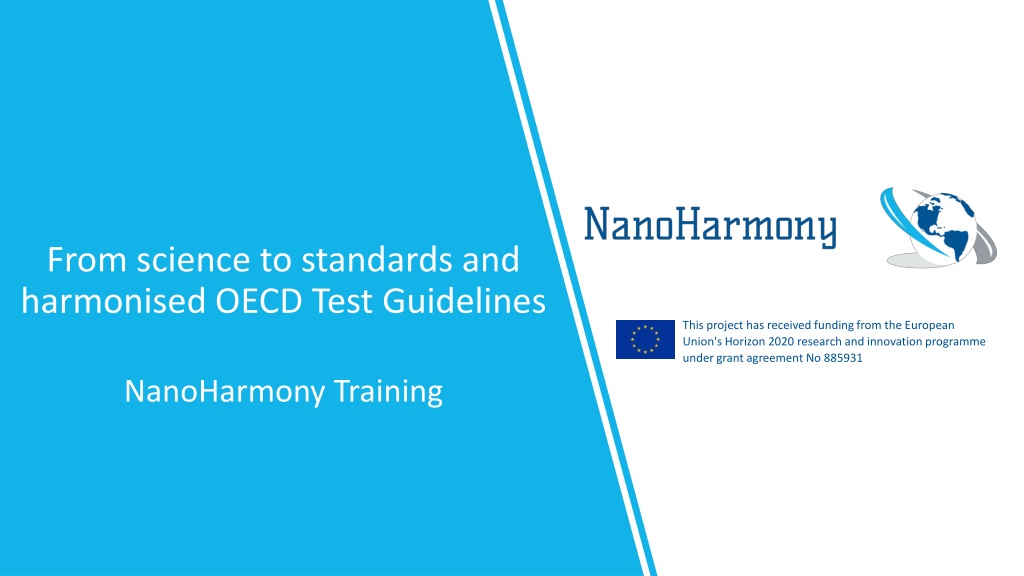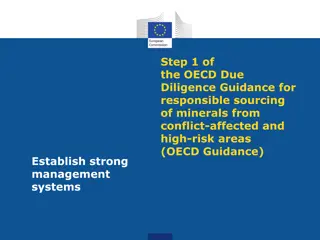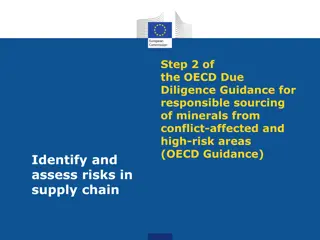NanoHarmony Training: Standards and OECD Guidelines Overview
Delve into the world of standards and OECD Test Guidelines with the NanoHarmony Training material. Learn about harmonized test methods, the role of science in guideline development, engagement with OECD committees, and the process of creating OECD Test Guidelines. Explore how stakeholders can contribute and benefit from this regulatory framework.
Download Presentation

Please find below an Image/Link to download the presentation.
The content on the website is provided AS IS for your information and personal use only. It may not be sold, licensed, or shared on other websites without obtaining consent from the author. Download presentation by click this link. If you encounter any issues during the download, it is possible that the publisher has removed the file from their server.
E N D
Presentation Transcript
From science to standards and harmonised OECD Test Guidelines This project has received funding from the European Union's Horizon 2020 research and innovation programme under grant agreement No 885931 NanoHarmony Training
Conditions of use The training material was developed within the project NanoHarmony (EU Horizon 2020 No. 885931). Attribution-NonCommercial 4.0 International (CC BY-NC 4.0): You are free to: Share copy and redistribute the material in any medium or format Adapt remix, transform, and build upon the material The licensor cannot revoke these freedoms as long as you follow the license terms. Under the following terms: Attribution You must give appropriate credit, provide a link to the license, and indicate if changes were made. You may do so in any reasonable manner, but not in any way that suggests the licensor endorses you or your use. NonCommercial You may not use the material for commercial purposes. No additional restrictions You may not apply legal terms or technological measures that legally restrict others from doing anything the license permits. From science to standards and harmonised OECD Test Guidelines
NanoHarmony The project Develop and validate Test Methods for OECD TGs/GDs The NanoHarmony legacy White Paper Training Material Formation of a network to interact with all relevant stakeholders Regular Online Workshops TGs and GDs for NMs Process Mentor Develop a structure to translate science into test methods used in regulation www.nanoharmony.eu + 18 int. assoc. partners From science to standards and harmonised OECD Test Guidelines
NanoHarmony Training: From science to standards and harmonised OECD Test Guidelines This set of slides provides a low-level entry into the topic of standards and harmonised OECD Test Guidelines and how science can contribute to this. The training set provides essential information on the topics of harmonisation of test methods, OECD and its relevant committees and documents, and the process of OECD Test Guideline development. This material was developed mid-2023. The Training Material is divided into 4 different modules, each focussing on a specific topic: 1. Importance of standardised and harmonised test methods What are harmonised test methods, why are they relevant and what are resulting benefits? How can my science contribute to an OECD Test Guideline? How are standards and harmonised test methods used? How does OECD fit in with other standardisation activities? The OECD and its relevant committees What is the OECD and which committees are relevant? What is the political structure of the OECD? Who are National Coordinators? The different documents in the OECD Test Guidelines Programme What are the different OECD documents? What are advantages of getting involved in their development? The process of development of OECD documents How is the OECD Test Guideline development process structured? Which stakeholders are involved in the development/revision/adaptation of OECD TG/GDs? How can stakeholders get engaged in the process? Further, more detailed information on the different phases of the OECD process is provided by the 2. 3. www.testguideline-development.org 4. From science to standards and harmonised OECD Test Guidelines
Importance of standardised and harmonised test methods This project has received funding from the European Union's Horizon 2020 research and innovation programme under grant agreement No 885931 Module 1 NanoHarmony Training: From science to standards and harmonised OECD Test Guidelines
Questions to the audience Do you know that Test Guidelines exist? What level of direct experience have you had with the OECD Test Guideline Programme so far? How many Test Guidelines / Guidance Documents / Standards have you used in your own work in any way? Q&A Have you developed or contributed any standards or OECD Test Guidelines in any of your work? Are you currently working in a scientific project that has any activities around contributing to standards or OECD Test Guidelines? From science to standards and harmonised OECD Test Guidelines
Importance and advantages of standardised and harmonised test methods Standardised and harmonised test methods are important for scientists, regulators, industry, testing laboratories, the general public, Facilitate knowledge transfer Reduce global trade barriers Safety assessment of chemicals and (new) materials Reduce number of (animal) test needed Testing safety during innovation process and during registration needs to be coherent Ensure comparability of results Can reduce operational costs Facilitate international cooperation Help to make regulation all over the world enforceable Opening new research fields From science to standards and harmonised OECD Test Guidelines
Standardised and harmonised test methods are used world-wide International standards ISO, CEN, OECD Test Guidelines National standards CYS (CY), DIN (DE), ILNAS (LU), NEN (NL), BSI (UK), ... Science General public Regulators Industry associations Industry Testing laboratories Non-profit organisations From science to standards and harmonised OECD Test Guidelines
Standardised versus harmonised test methods Standardised test methods Harmonised test methods Developed and validated by different standardisation bodies (e.g. ISO, CEN, national standardisation bodies) Developed and validated by the Organisation of Economic Co-operation and Development (OECD) Market need Regulatory need More industry driven Communication among industry More government driven Data gathering and enforcement of legislation The development process usually takes about 3 years The development process can take 2-5 years on average Purchase for (small) fee Public access ISO www.iso.org Organisation of Economic Co-operation and Development (OECD) www.oecd.org From science to standards and harmonised OECD Test Guidelines
Organisation of Economic Co-operation and Development (OECD) Intergovernmental organisation 38 Member countries representatives and European Commission Industry representation (Business & Industry Advisory Committee, BIAC) Animal welfare organisations (International Council on Animal Protection in OECD Programmes, ICAPO) Green NGOs Other partners (e.g. China, Malaysia, Thailand, South Africa) International Organisations (e.g. WHO, UNITAR, UNEP, ISO) Member countries Accession candidates Key partners OECD covers more than 27 different topics Organisation of Economic Co-operation and Development (OECD) One of them is chemical safety and biosafety www.oecd.org From science to standards and harmonised OECD Test Guidelines
Mutual Acceptance of Data (MAD) Helps to avoid conflicts or duplication in national requirements Provides a common basis for cooperation among national authorities Avoids creating non-tariff barriers to trade Saves the chemicals industry the expense of duplicate testing for products which are marketed in more than one country https://oe.cd/chemicals-costs OECD Member countries and full adherents have agreed that a safety test carried out in accordance with the OECD Test Guidelines and Principles of Good Laboratory Practice in one OECD Member country must be accepted by other OECD Member countries for assessment purposes tested once, accepted for assessment everywhere Test study data shall be accepted, but interpretation and exact use of the data may differ between countries. Mutual Acceptance of Data (MAD) www.oecd.org/chemicalsafety/testing/mutualacceptanceofdatamad.htm From science to standards and harmonised OECD Test Guidelines
OECD Test Guidelines are part of the Mutual Acceptance of Data tested once, accepted everywhere Test Guidelines Good Laboratory Practice A single quality standard for test facilities throughout OECD Chemicals / Nanomaterials A single quality standard should be applied for testing of all chemical substances Mutual Acceptance of Data (MAD) Legally binding on OECD Member countries and other MAD Adherents* *Argentina, Brazil, India, Malaysia, Singapore, South Africa and Thailand From science to standards and harmonised OECD Test Guidelines
What are advantages for scientists of getting involved in test method development? New network and opportunities created during development (e.g. interaction with National Coordinators and experts) Gaining valuable experience (e.g. to find a job in industry or risk assessment) Papers are cited more if they are useful for regulators (e.g. for an OECD dossier) Production of regulatory usable science, i.e. your science will be used (e.g. Mutual Acceptance of the Data) Identification of new fields and scientific questions (e.g. new endpoints, new materials, new safety assessments) Contribution to a safer and more sustainable world From science to standards and harmonised OECD Test Guidelines
Potential ways to include scientific work in standardisation and harmonisation efforts Development of experimental procedures Establishment of standard operating procedures (SOPs) SOPs that can be further validated More focus on regulatory needs Broader validation on reproducibility, transferability of method Keep in mind: a SOP is not (yet) a Test Guideline or a standard Adverse outcome pathways (AOPs) can help structuring a series of Test Guidelines to get information on the different key events Commenting of draft documents and contribution to expert groups Adverse outcome pathways: https://www.oecd.org/chemicalsafety/testing/adverse-outcome- pathways-molecular-screening-and-toxicogenomics.htm Draft Test Guidelines for public comments www.oecd.org/chemicalsafety/testing/chemicalstestingdraftoecdguidelinesforthetestingofchemicals-sections1-5.htm From science to standards and harmonised OECD Test Guidelines
Take Home Messages Standards industry driven, Harmonised test methods government driven MAD: tested once, accepted for assessment everywhere Standards and harmonised test methods are essential for all stakeholders OECD TG/GD Process Mentor www.testguideline- development.org A Standard Operating Procedure (SOP) is not (yet) a Test Guideline or a standard Getting involved as a scientist in the TG development is important and advantageous From science to standards and harmonised OECD Test Guidelines
Sources for further information OECD www.oecd.org ISO www.iso.org CEN ww.cencenelec.eu Mutual Acceptance of Data (MAD) www.oecd.org/env/ehs/mutualacceptanceofdatamad.htm video www.youtube.com/watch?v=dD7e1sfsh3A&t=6s OECD Test Guidelines Programme www.oecd.org/chemicalsafety/testing/oecd-guidelines-testing-chemicals-related-documents.htm Adverse Outcome Pathways (AOPs) at OECD www.oecd.org/chemicalsafety/testing/adverse-outcome-pathways-molecular-screening-and-toxicogenomics.htm NanoSafety Cluster www.nanosafetycluster.eu NanoHarmony Webinars on NanoHarmony www.nanoharmony.eu NanoHarmony webinars https://www.youtube.com/playlist?list=PLl8XHGDKVfG7jZ0i0mkXOua3YLkMLSCSh From science to standards and harmonised OECD Test Guidelines























